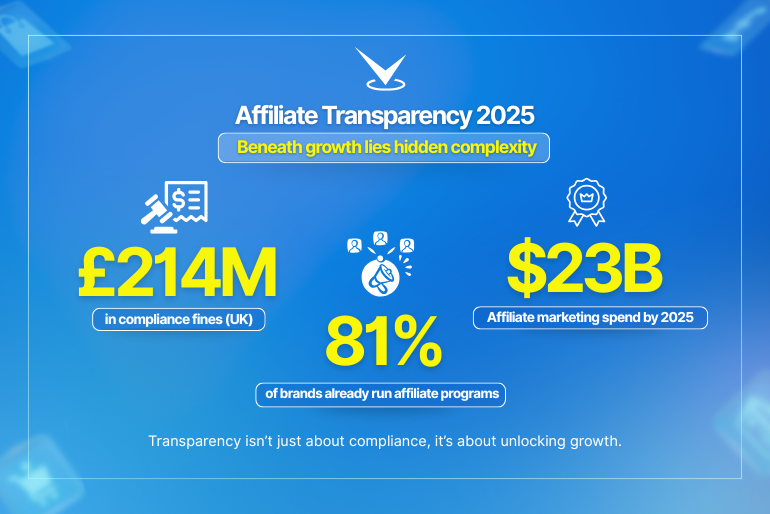In the dynamic world of digital marketing, affiliate marketing serves as a cornerstone for customer acquisition and brand expansion, with a projected market growth exceeding $23 billion in 2025, according to the Global Growth Insights report on Affiliate Marketing.
With an estimated 81% of brands said to have an affiliate program and the increasing use of technology used to promote brands, trust and transparency have never been more important. Beneath the surface of most, if not all, affiliate programs lies a complex web of unknown sub-affiliate networks that can obscure revenue opportunities and expose brands to regulatory risks.
The Hidden Layers of Affiliate Marketing
Affiliate marketing often extends beyond direct partnerships. Sub-affiliate networks—third-party affiliates promoting offers through approved affiliates—can introduce additional layers of complexity when undisclosed. These sub-affiliates may operate under different unvetted marketing channels, utilise unauthorised or outdated promotional offers, or target inappropriate audiences, making them challenging to identify and manage.
The opacity of these undisclosed networks can lead to revenue losses or worse, brand disrepute.
Regulatory Scrutiny and Financial Implications
The lack of transparency in affiliate marketing has caught the attention of regulators. In 2023, the UK’s igaming regulatory authority, UKGC, for instance, imposed fines of over £214 million on its members, much of which was tied to the marketing practices of third-party affiliates.
In July 2025, the Advertising Standards Authority (ASA) upheld a complaint against a UK sports betting brand after an affiliate advertisement appeared on an esports site and was viewed by a registered underage user. This incident illustrated the potential consequences of inadequate affiliate transparency, including reputational damage and regulatory action.
The Strategic Value of Transparency in Affiliate Marketing
Transparency in affiliate marketing is more than a compliance requirement—it’s a growth engine. When brands gain a clear view of their affiliate networks, including any undisclosed sub-affiliate activity, they can uncover previously invisible marketing practices. These insights can directly translate into risk mitigation, avoidance of potential regulatory failure and fines, improved brand control, and more effective partnerships that ultimately contribute to increased revenue.
Here are some tips on gaining transparency and leveraging it for positive outcomes:
Discover Untapped Placement Opportunities
Not all pages where your brand could be promoted are being utilised. Approved affiliates and their known sub-affiliates often manage multiple websites or pages, some of which may not currently feature your offers. By mapping these properties, brands can ensure they are represented across every relevant page, increasing visibility and click-through potential.
Identifying Pages for Higher Rankings
In many cases, affiliate links are placed on pages that are under-optimised or not receiving sufficient traffic. Transparency tools enable brands to see where their campaigns appear and identify higher-potential placements or targeted areas. This ensures your marketing investment reaches its full potential.
Uncovering Additional Websites and Assets
Many affiliates operate multiple websites or subdomains that are not immediately visible to affiliate managers. Without full transparency, these sites remain risky as well as untapped sources of revenue. By discovering these additional properties, brands can extend their promotions to reach new audiences without needing to find new affiliates from scratch.
Optimising Existing Relationships for Growth
When brands have full transparency and a good understanding of their affiliates’ assets and reach—including their networks of sub-affiliates—they can better negotiate terms, provide tailored creative assets, and incentivise performance. Transparency transforms affiliate management from a reactive process into a proactive strategic partnership that drives growth for both parties.
Mitigating Missed Revenue and Compliance Risks
Beyond growth, transparency ensures that affiliate-driven traffic is tracked, accounted for, and compliant with regulatory standards. This prevents lost commission payouts from unauthorised or hidden links while protecting from potential fines or reputational damage due to non-compliant placements.
Conclusion
In a hyper-growth marketing landscape, affiliate marketing must be approached with a focus on transparency and comprehensive insight to achieve a positive and sustainable outcome.
In essence, transparency equips brands with a level of insight that helps to efficiently turn hidden opportunities into measurable revenue growth while protecting from potential risk. Tools that enable affiliate managers to see their affiliate footprint deeply can empower them to optimise their budgets effectively and maximise returns.
You too can unlock your hidden revenue opportunities and/or identify risks you may be exposed to. Don’t wait. Book a personalised demo with one of our team members today.



 by Shenaly Amin | 27 Oct 2025
by Shenaly Amin | 27 Oct 2025
 3-min read
3-min read
